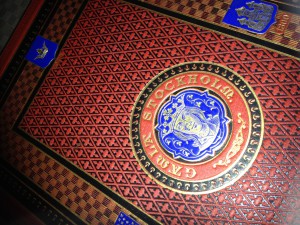The haunted places in Stockholm
Stockholm, Sweden's historic capital, carries a mystery that goes back a long way. Beyond the busy streets and beautiful architecture, there are places said to be haunted by ghosts and spirits. These haunted places have become sources of fascination and terror for those who dare to explore the supernatural.
In this article, we take you on an exciting journey through Stockholm's most famous haunted places. From the old royal castle to hidden alleys and abandoned buildings - each place carries its own unique history and tales of supernatural phenomena.

I did a ghost walk in August Strindberg's footsteps together with my 15-year-old son. These are the various haunted places that Strindberg described in the book Gamla Stockholm,
The corner of Sankt Paulsgatan and Bellmansgatan
Nootska palatset The 17th-century palace is referred to in Erik Dahlberg's classic work Svecia as Palatium illustr. Judgment. van der Noot. The place has been considered a haunted house and, according to Strindberg, was originally owned by the Beautiful Water Nymph Melusina whose image appears in the frontispiece (hmm the frontispiece should mean the main phase of a building, alternatively a projecting central part of the main building or cornice).
I couldn't spot Melusina's picture and maybe that was lucky because on Saturdays she becomes half woman and half snake. The rest of the days, Melusina can apparently live like an ordinary person, but according to legend, she must hide when she takes her Saturday bath. There is said to be a room in the house that no one dared to open, and there the beautiful Melusina had her bath. The house has since belonged to Queen Kristina.
The cat at Västerlånggatan 24
The story of the cat on Västerlånggatan is about a ship that was on its way home but ended up at a stand still for three days and the crew suffered because it was terribly hot. After offering a penny over the leeward edge of the mainsail, the sea opened and a staircase became visible and up it a beautiful woman ascended. The mate came forward and saluted and the woman asked him to follow. He followed her down the stairs and arrived at a palace. "Look here," she said, "take this letter and go up to the house no ... at Västralånggatan, ask there for Mr. Måns and leave it to him." But you must not do anything else, but this must be the first thing you do after the gangway is laid out.”
Five days later the ship was in Stockholm and they began to unload the cargo. The mate couldn't get away to go up with the letter, which he didn't consider so important either, that it took a few days...
One day the mate came to the kitchen where the maids were sitting and they told me that the only moon they knew was the cat, which was an unusually large cat. The cat came forward and said in a voice "Take here the letter" then he read it. Big tears flowed from his eyes and then he said “It would have been better for you and me if you had kept your promise and come here right away. The cat then jumped on the mate and clawed him to death. He then went out through the window but stopped on the sheet metal above the gate where he was turned to stone. What was in the letter no one could understand because it was written in an incomprehensible language.
The stone over the gate at Västerlånggatan 24 still stands, and it looked quite scary, but at the end of the 19th century there were two stones with cats over the gates.
Drottninggatan 110 (Spökslotlett)
We walked up Drottninggatan and looked at the Strindberg quotes in the ground and the blue tower where Strindberg lived.
Unfortunately, one of his most beautiful quotes was not included among those erected as a work of art on the ground ie
Cry, cry until the source of tears runs dry. And then raise your face.
Finally we reach Drottninggatan 110 which didn't look so spooky. Was it newly built in the 20th century?
(Later someone commented that Drottninggatan 110 did not look a bit ghostly because Spökslottet is located at Drottninggatan 116 today as the street's house number has changed since Strindberg's time.)
Strindberg had written that a Dutchman named Scheffel or Schäffler must have lived in the house and is buried in the garden. During the Riksdag in 1746, the English minister Guidickens was forced to release the detained merchant Springer who had sought refuge in the building. At the end of the 18th century, the house was owned by mill patron Knigge, who gave rise to many ghost stories told about the property.
A man Knigge disappeared without a trace from the haunted castle. He was known to be a very cruel and mean man and according to a story a wagon drawn by snorting horses had been seen stopping outside the gate. Knigge climbed into the carriage and it disappeared with an unnatural speed with sparks and flames. It was generally said that "hell took the Kniggen".
A person who had lived in the ghost castle has told us that every evening a small white cross appeared on one of the walls. They looked everywhere to see if it came from some light, but they never found anything.
Clara Nunn
In Clara's school there is said to be a very mysterious person. She once lay in the burial cellar on the east gable where a window is visible. And whoever saw the coffin there did well to spit three times after him according to August Strindberg. In the 1850s, a rumor spread that Clara the nun had appeared in the cemetery and several people came to the cemetery at dusk to see her. Oddly enough, she is said to have appeared on one of the walls of the burial choir with a black dock, a rope around her waist and a book in her hand. So many people gathered that the police had to intervene before it was discovered that it was some pranksters who, from a window and a laterna magica, had conjured up the image of St. Clara. The matter was hushed up.
Piper wall
Behind the Piper wall on Kungsholmen there is a high mountain called Jungfruberget where a girl is said to have been taken from the mountain. To be taken from the mountain means that a supernatural being had lured the woman to their abodes underground - and the people often had a strong change of mind when they were set free.
Large children's house
A white woman was seen at the children's home and the nurses believed in the 19th century that she watched over the mothers so that they would not neglect the little ones.
Luntmakargatan
The devil made a terrible noise in December 1733, says Rudling on Luntmakargatan and Olof Berg's farm, which was heard by several hundred people. The noise stopped shortly before the end of the Christmas season.
Source: Old Stockholm
Printed 1882 Central printing house
Claes Lunding and August Strindberg





Cool idea. The fact that Drottninggatan 110 did not look a bit ghostly is because Spökslottet is located at Drottninggatan 116 today, as the street's house number has changed since Strindberg's time. As I said: fun idea to ghost walk after Strindberg.